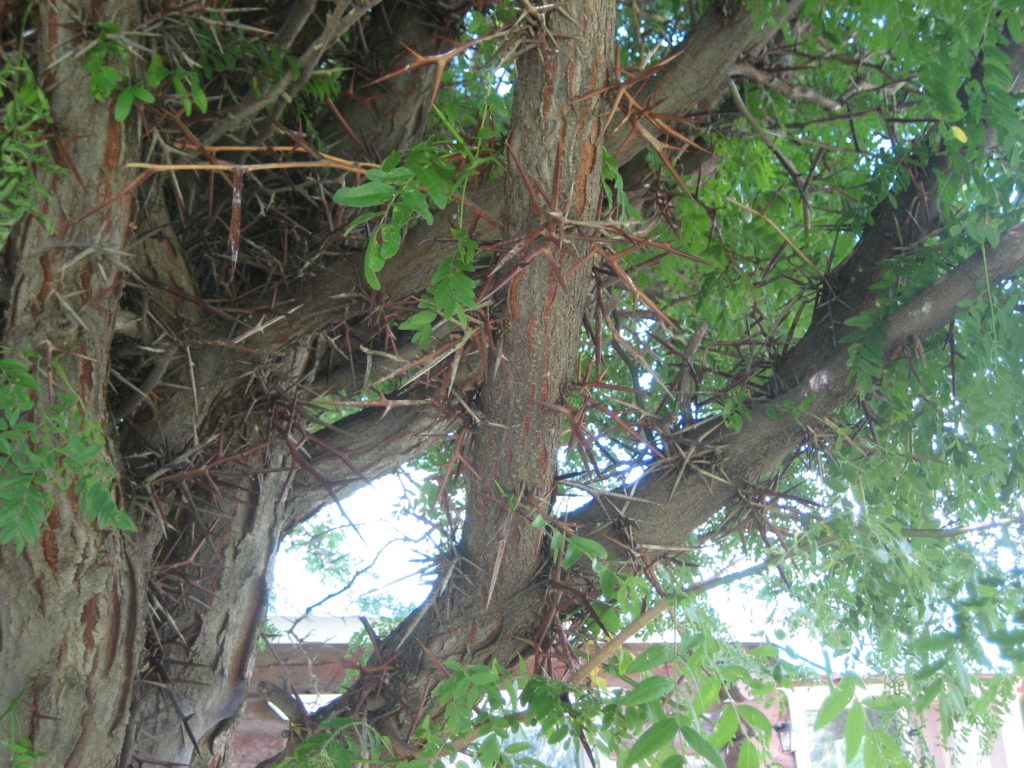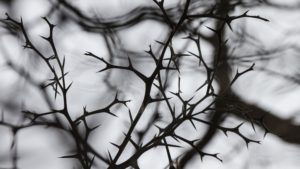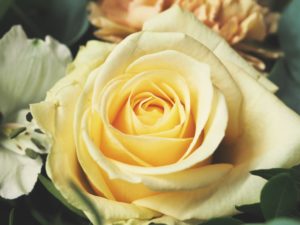The seed for this post was a piece of writing by Dr. Sharon Blackie about the protective nature of thorny plants. This is a subject I’ve researched, not just as a gardener but also because of my fascination with folklore and tradition. I’ve written previously about brambles being a deterrent to vampires.
Reading Blackie’s musings on thorns reminded me of a honey locust tree I lived with in my old place in Colorado. It was covered with long, sharp thorns that punctured tires and easily passed through soft-soled shoes and sandals. It stood just off my porch, giving generous shade in the summer. I hung bird feeders in it, touched it, talked to it and moved respectfully and mindfully under and around it. The thorns contained some kind of irritant, and a scratch or stab from one of them resulted in several days of painful swelling.
The tree commanded attention, not only because of the fabulous covering of thorns and its harsh beauty, but also because it was the neighborhood tenement for birds. During the summer I often expected to see the whole tree rise into the air and fly away, powered by what seemed like hundreds of birds mating, nesting, hatching, quarreling, singing and living their lives among its thorny branches.

I loved that tree. It was one of the hardest things to leave when I came to Maine. Several people, including the people from whom I bought the house, advised me to cut it down. The thorns were destructive and dangerous. It was ugly, a nuisance.
I was fiercely protective of the tree, seeing in it what I wanted for myself, the ability to self-protect and still be beautiful and nurturing to others. Since I’ve left that place I’ve often thought of the locust and wondered if the new owners have cut it down. I hope not. If so, I don’t want to know.
I came to Maine and learned about needs. Then, in the course of writing my books, I researched thorny plants and learned thorns are in fact modified leaves, roots, stems or buds, and plants evolved them in order to protect themselves from being eaten.
Some plants evolved with thorns in order to protect themselves from being eaten. In order to survive. No plant evolved thorns in order to scratch, sting or pierce you or me specifically. The adaptation of thorns is about the needs of the living being we call a honey locust, a bramble, a hawthorn or a rose. Self-protection is about the life form employing it, not anyone else.

This seems to me an important distinction, and a metaphor for human choice and behavior. When I came to Maine I believed it was my job to protect everyone around me. Self-protection, however, was absolutely taboo. Any attempt to have boundaries, say no, speak my truth or move from the place the blow was going to land was severely punished. As I learned emotional intelligence and my priorities began to move from caring for and pleasing others to caring for and pleasing myself, I felt threatened and disliked from every side. I allowed myself to be made to feel destructive, dangerous and ugly.
Just like my beloved locust tree.
Sometimes it’s hard to understand why people make the choices they make. This is particularly difficult in the case of close relationships. In fact, it can be difficult to understand our own behavior and motivation. We humans are quick to make what others do about ourselves, to exercise our outrage, be critical and judgmental and disempower those who we feel threaten our beliefs, our position, our power to choose. Most of the time, though, the people around us are doing exactly what we’re doing ourselves. They’re simply trying to meet their own needs.
It always comes back to some kind of a need. When I became aware of my own needs, I quickly understood nearly every choice I’ve ever made had been motivated by trying to stay safe. For a long time I was trying to get loved in order to stay safe, but it didn’t work and I’ve shifted now to the true bottom line.

I need to protect myself.
That’s pretty clear and simple. I am not confused or ashamed about it. The difficulty arises as I interact (or choose not to) with others. That simple, clear bottom line gets buried under emotion; my stories and assumptions about myself and others; my eagerness to be understood; my hope to be validated and supported; and my justification, explanation, shame and guilt as others react to my choices for self-protection.
I don’t think most of us have trouble understanding and recognizing the core drivers for human beings. We want to be loved, accepted and seen as we really are. We want healthy relationships. Some people want money and power. Some seek control. We want to protect ourselves and others, as well as maintain autonomy and freedom of choice. We may not agree with the priorities of those around us, but they’re not foreign to us.
The methods we use to meet our needs are where the trouble begins. I know from personal experience pleasing people and having no boundaries leads to neither love nor safety, but it took me decades to discover that, decades during which I strove desperately to earn love and achieve security using those methods without success. To an outside view, I can understand why now I seem like a different person, hard, uncaring, unloving, selfish and disloyal.
This is terribly ironic, as no one knows of our private anguish and suffering as we strive to grow, heal and change, unless we reveal it, and I work hard to never reveal mine, not necessarily because I want to shut people out or hide things, but because I am trying to stay safe, and bitter past experience has taught me revealing my soft underbelly is dangerous.
Because I realize my own methods for meeting my needs are frequently problematic and inefficient as well as inscrutable to others, I’m able to have more space for others and the choices they make. Life protects itself. Life wants to go on living. Sometimes the strategies we use to achieve those goals hurt others, and sometimes they hurt ourselves, but in a world so full of people it’s bound to be a confusing mess. This is a perfect frame for the current debate around vaccines. Both sides are trying to protect against perceived threats to self, others and freedom of choice. There isn’t going to be an easy answer.
I wish I could be like the locust tree that graced my old life. It hid nothing, apologized for nothing, stood tall and shapely and branching, and protected itself as well as sheltered all kinds of life. To my eyes it was beautiful beyond words, a powerful teacher, a being I reverenced. I accidentally trod and knelt on its thorns more than once, but I did not blame the tree. I would not have allowed it to be cut down.

Locust, bramble, rose, hawthorn, holly and blackthorn. Thorns and prickles and spines. Fruit, flower and healing herb. Haven and shelter for insects, birds, small rodents and reptiles.
Life that cannot protect itself will not survive. Yet sometimes the price of self-protection is so high I wonder if it’s worth survival. It’s not so very hard to cut down a tree, if its thorns offend us. It’s not so very hard to destroy a human being, either, if their efforts to meet their own needs offend us.
I never would have guessed at the pain involved in committing to protect myself. It never occurred to me I would feel forced to choose between my love and care for others and my own needs. I still don’t understand why that should be so, but it feels as though it is.
I hold in my heart the memory of my locust tree, and how the inability of some to appreciate its beauty made it seem even more precious and powerful. Fierce, unapologetic self-protection and abundant life. The memory comforts and inspires me. I want to grow up to be like that.
© 2019 – 2022, Jenny Rose. All rights reserved.